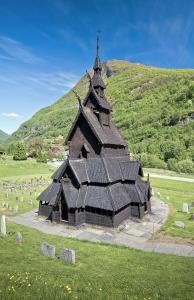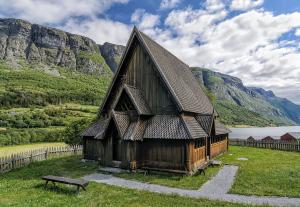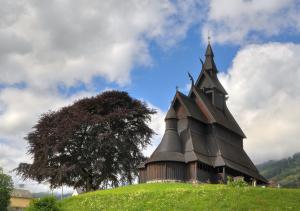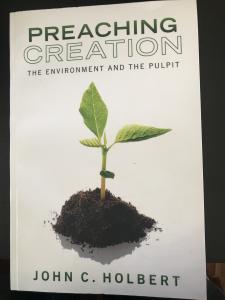 In July of 2011, my wife and I went to Norway, a place both of us had long wanted to see. We had seen many pictures of the place, but were frankly not prepared for the astonishing beauty we were about to experience. Norway is nothing less than a postcard around every turn in its roads, north to south and east to west. In 2017, Norway was named home to the happiest people on earth, displacing Denmark in that enviable position. Little wonder! To look on that scenery for the whole of a life would put a wide grin on the most lugubrious of countenances.
In July of 2011, my wife and I went to Norway, a place both of us had long wanted to see. We had seen many pictures of the place, but were frankly not prepared for the astonishing beauty we were about to experience. Norway is nothing less than a postcard around every turn in its roads, north to south and east to west. In 2017, Norway was named home to the happiest people on earth, displacing Denmark in that enviable position. Little wonder! To look on that scenery for the whole of a life would put a wide grin on the most lugubrious of countenances.
We flew into Oslo, the capital, and spent two days there, exploring the city a bit, especially the amazing Vigeland Park, filled to the brim with the astonishing outdoor art of Norway’s most recognized sculptor, Gustav Vigeland. At every turn, his towering creations, sometimes whimsical, sometimes darkly cynical, confront the viewer as she strolls through the vast green space. We were there on a glorious July day, and took full advantage of our time. Our hotel presented an unfortunate challenge, since it was chock-a- block with youthful soccer players in town for a national tournament. We moved rooms twice in the attempt to escape the noise, but it was impossible since screaming teens made their presence known all night long, hanging out windows and generally allowing hormones to rule. In the morning we moved to another, far quieter, hotel.
Then we went west by train to Bergen, a lovely city on the water, home to Edvard Grieg, Norway’s national composer. He actually lived somewhat south of the city in a small and breathtakingly beautiful village, composing many of his most famous works in a spacious room overlooking a tranquil lake. We were fortunate to hear a fine concert in a hall on the grounds that included several of his works.
After that superb experience, we rented a car and headed north, up the coast on one of the country’s main highways. However, we soon discovered that an interstate or Autobahn it was not! Our trip was punctuated by many ferry rides, since the North Sea and several ice ages had millennia ago cut deep channels into the western shelf, thus fashioning the lovely fjords, the signature architecture of the landscape of the country. So, we would drive a few miles, come up to a channel, await a ferry, load ourselves and our car on board, and sail to the next hard land road. And, to make the scene complete, on two occasions we were slowed to a crawl by herds of sheep on the highway. Since I now live in LA, I have tried to imagine just what would happen if a flock of sheep suddenly impeded traffic on the 405 some morning during rush hour. I fear lamb chops would be on the menus of many Angelenos that night! But in Norway, we waited patiently as the sheep were eventually shooed from the main highway, and we, and they, went on our way.
We were headed for a Bed & Breakfast in the north of the country. It proved quite difficult to find, causing us to spend an extra night in a hotel across some body of water that, if we had had a clear map of our final destination, would not have been necessary at all. After finally discovering the spot, we settled in for three days of relative quiet and rest. Then it was back in the car for a return to Bergen and a night train to Oslo and then home.
 However, on the return to Bergen we stopped at several of the amazing Stave churches, those giant wooden structures that dot the landscape, some of which are 700-900 years old. It is frankly unimaginable how wooden buildings like these could have survived 900 Norwegian winters, until one remembers that what the Norwegians know best are the ways wood can withstand water. They had vast fishing fleets that plied the icy waters of the North Sea and beyond for centuries, learning by trial and error how boats can year after year withstand the depredations of sea and air in a forbidding climate. Hence, that technology was translated to the building of churches, structures nearly unique in the world (there remain perhaps two Stave churches outside Norway). The word “Stave” is Old Norse for the “stavr,” or load-bearing lintel that keeps the building alive.
However, on the return to Bergen we stopped at several of the amazing Stave churches, those giant wooden structures that dot the landscape, some of which are 700-900 years old. It is frankly unimaginable how wooden buildings like these could have survived 900 Norwegian winters, until one remembers that what the Norwegians know best are the ways wood can withstand water. They had vast fishing fleets that plied the icy waters of the North Sea and beyond for centuries, learning by trial and error how boats can year after year withstand the depredations of sea and air in a forbidding climate. Hence, that technology was translated to the building of churches, structures nearly unique in the world (there remain perhaps two Stave churches outside Norway). The word “Stave” is Old Norse for the “stavr,” or load-bearing lintel that keeps the building alive.
It is difficult to describe these churches, so I will include several photographs in this article to show them to you. It is equally difficult to describe the effect these buildings have on the viewer. They tower, literally, over their landscapes, and can be seen for some miles before entering their immediate locations. In that way, their effect is not unlike the massive cathedrals of Europe and especially England whose spires dot the air of the country sides, announcing to all who see them that God is alive in the land and that God is ready and anxious to lead the people. That may sound romantic, but surely that was, and is, the intent of these buildings. Yet, few of these structures any longer house vibrant congregations of the faithful. They are now haunts of tourists, primarily. Still, there remains something intangible about them. Perhaps a poem by Phillip Larkin gets at that intangible quality:
It is equally difficult to describe the effect these buildings have on the viewer. They tower, literally, over their landscapes, and can be seen for some miles before entering their immediate locations. In that way, their effect is not unlike the massive cathedrals of Europe and especially England whose spires dot the air of the country sides, announcing to all who see them that God is alive in the land and that God is ready and anxious to lead the people. That may sound romantic, but surely that was, and is, the intent of these buildings. Yet, few of these structures any longer house vibrant congregations of the faithful. They are now haunts of tourists, primarily. Still, there remains something intangible about them. Perhaps a poem by Phillip Larkin gets at that intangible quality:
A serious house on serious earth it is,
In whose blent air all our compulsions meet,
Are recognized, and robed as destinies.
And that much never can be obsolete,
Since someone will ever be surprising
A hunger in himself to be more serious,
And gravitating with it to this ground,
Which, he once heard, was proper to grow wise in,
If only that so many dead lie round. (“Church Going”)
I readily admit that I, too, am ever surprising myself to be more serious, and over and again find myself “gravitating” with that hunger to this ground, the ground of the church. Granted, the church has been both my life and my business for nearly 50 years, and that fact surely determines my continued refusal to avoid the church or to denigrate the church as the sometimes appalling and empty place that it can too often be in this world of pains and inequities too numerous to name. Churches remain still places, we once heard, “to grow wise in,” and as I stood outside a huge Norwegian Stave church, I knew it for such a place and honored it for its 800 years of serious ground, a place where I am certain any number of old Norwegians grew wise in and led to these modern, supremely happy Norwegians of the 21st century.
Tourist places they may be, but they are far more for those of us who can still appreciate the serious earth on which they stand. The one we saw and visited and entered stays clearly in my mind since I saw it now 6 1⁄2 years ago. And I still thank God for its enduring witness to wisdom and faith.
(Images from Wikimedia Commons)











